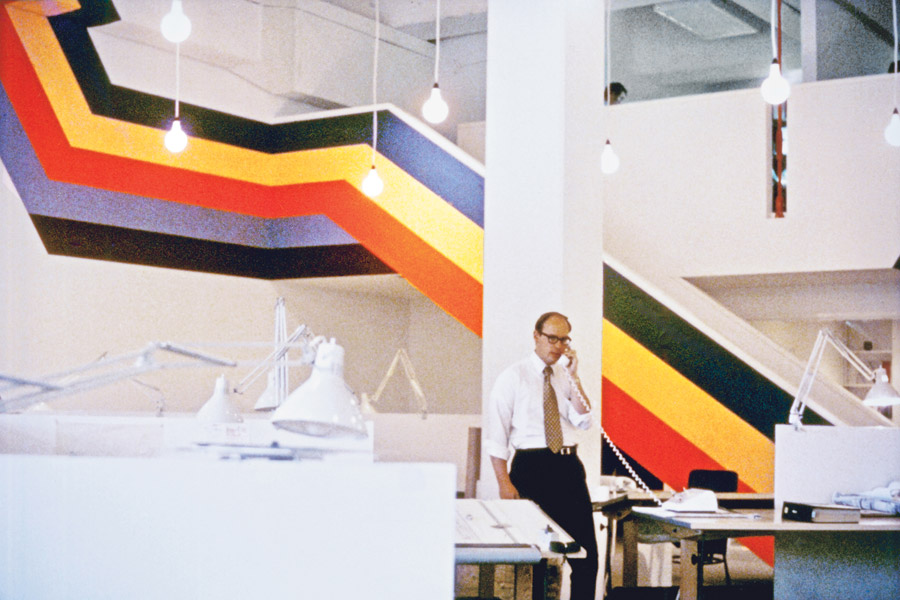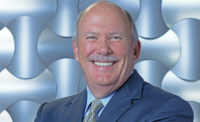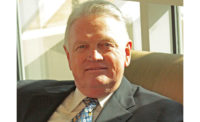Big ideas have never daunted Patrick MacLeamy. Building teams that are courageous enough to pursue them is the more important challenge, says the former CEO of architectural and design firm HOK.
“When you can get people to treat each other like friends and family, then you really have something,” says the now retired MacLeamy.
In MacLeamy’s half century at HOK, that philosophy proved pretty successful. Eli Hoisington, who now shares the firm’s co-CEO role with Susan Klumpp Williams, credits MacLeamy with building the once-regional firm into a prestigious global design practice with offices and landmark projects on nearly every continent.

HOK's first regional office was opened by MacLeamy in San Francisco in 1970.
Photo courtesy HOK
“You look at what HOK was when he took over and what he handed off, and it’s just extraordinary,” Hoisington says of MacLeamy’s legacy. “Bringing HOK into what it takes to be a large international business takes a Patrick-level thinker—to be management, but also have a vision. There are only a handful of firms that have our skills, and he was the catalyst for it.”
Along the way, MacLeamy was an early champion of new technologies and encouraged the use of collaboration tools to improve the practice of architecture. Those efforts led him to the formation of buildingSMART International (BSI) and development of interoperable digital standards at the heart of BIM and other collaboration tools now widely used across design, engineering and construction.
That impressive slate of accomplishments has led ENR to name MacLeamy winner of the 2024 Legacy Award for Northern California.

Among the major design projects MacLeamy lead at HOK was the King Khalid International Airport in Riyadh, Saudi Arabia.
Photo courtesy HOK
Projecting a Path
MacLeamy’s career with HOK began in 1967 as he neared the end of his architecture studies at the University of Illinois and ventured to St. Louis for a job interview with HOK founding partner Gyo Obata.
“He electrified me with his passion for what the firm could do,” MacLeamy says.
Expecting to spend only a few years at HOK, MacLeamy ended up staying for exactly 50 years. Every time he got “itchy feet,” he says, the firm’s leaders offered up an intriguing opportunity, the most pivotal of which was being selected to open HOK’s first satellite office in San Francisco.
MacLeamy’s superiors also encouraged him to apply his talent for organization by shifting from design work to project management, a role that required learning many things on the fly, including the difference between managing and leading.
“It’s a lot more than just having people do things and offering advice,” he says. “Fortunately, I’d had a lot of good mentors at HOK and was able to apply things they’d taught me.”
“It’s the firm’s job to take care of its people so that those people can take care of their client.”
—Patrick MacLeamy
MacLeamy quickly understood that building strong business relationships—both within and outside the building—were a critical element to success.
“It’s the firm’s job to take care of its people so that those people can take care of their clients,” he says. “That means a steady paycheck, good benefits, interesting projects to work on and an opportunity to move up in the firm as they grow in skill and ability.”
Hoisington says he’s taken MacLeamy’s many teachings to heart during his own leadership path at HOK.
“As you get into leadership, you can very easily get conservative,” he says. “Yet Patrick was willing to take risks, and he was usually right. One of his quotes, ‘run to trouble,’ is so simple, yet it’s not something everybody does.”

The design of San Francisco's Moscone Center was another major HOK project led by MacLeamy.
Photo courtesy HOK
Ideas and Improvements
MacLeamy just as willingly shared lessons learned and personal insights with colleagues and competitors alike, including the eponymous “MacLeamy Curve” that shows how frontloading resources early in the design stage prevents costly changes once construction begins.
Similarly, the mid-1990s impetus to lay the foundation for BSI grew out of MacLeamy’s frustration with trying to describe ever more complex three-dimensional buildings using two-dimensional pieces of paper. Though nascent computer-aided design (CAD) technology had made inroads in the design industry, MacLeamy wanted to take it further.
“Computers, which were getting increasingly powerful, could coordinate and check things with a speed and accuracy beyond what humans could do,” he says. “We needed a way for these 3D drawings to be standardized so that they could be easily exchanged with software not just across the design team, but also by the engineer and contractor.”
MacLeamy found a kindred spirit in Ian Howell, an Australian architect who at the time was Autodesk’s director of AEC products and industry marketing. At a meeting with MacLeamy in San Francisco, Howell described an Autodesk initiative to utilize object-oriented programming as a software design paradigm rather than the long-standing logic-based approach.
At the end of what Howell characterizes as a rather technical conversation, “Patrick said, ‘I haven’t understood half of what you told me, but the other half sounds really important.’”
Howell adds that MacLeamy “saw the business value of this approach, particularly using open-source standards that could be incorporated into other design and information management software to enhance portability and reuse, regardless of the user’s platform.”
MacLeamy’s enthusiasm for open standards would prove instrumental in gaining buy-in from both U.S.-based software developers and large design firms and then from their overseas counterparts. Though the effort entailed extensive globe-trotting, hours of meetings and taking on the unfamiliar role of fundraiser to sustain the initiative, MacLeamy helped guide BSI from its all-volunteer origins into a London-based nonprofit dedicated to creating open standards for developing BIM software that has since been adapted for infrastructure and other systems throughout their life cycles.
Howell has no doubt that MacLeamy enjoyed his “day job” of leading HOK. But spearheading BSI, he says, “gave him the opportunity to pursue his passion of trying to improve the many flaws in our industry—fragmentation, late or overbudget projects and obstacles to communication.”

MacLeamy inspects an HOK job in Oslo in 2010.
Photo courtesy HOK
Active and Engaged
Though he’s stepped away from business and industry leadership roles, the 81-year-old MacLeamy is anything but a stereotypical retiree. Along with sharing a busy slate of local volunteer activities with his wife, Jeanne, an architect who he met while at HOK, he continues to share his visionary thinking with the industry he loves and has helped shape. Along with podcasts and speaking engagements, he’s working on a book outlining problems and solutions for the global building and infrastructure industries.
“Architects and contractors should be sharing ideas rather than being in separate camps,” he says. Always eager to embrace innovations, he believes digital twin technology offers great promise to better inform designs and their functionality throughout an asset’s life cycle.
Even with his expertise and insights, MacLeamy says he continues to learn, another lifelong pursuit that began with his grandfather, a carpenter who designed houses based on experience and observation rather than formal training.
MacLeamy believes “Pop” would be impressed, and not a bit gobsmacked, by the accomplishments of the little grandson who regularly pestered him for a turn at drawing house plans. One particular lesson that has stayed with MacLeamy is a corollary to the carpenter’s dictum, “measure twice, cut once.”
“Cutting incorrectly wastes time,” MacLeamy says, “and I remember Pop saying ‘you can never get that time back.’ I carried this valuable lesson throughout my life and career as an architect, and I would love to thank him for it.”





Post a comment to this article
Report Abusive Comment